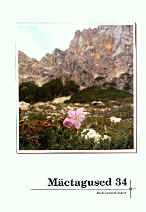Hüperventilatsiooni ilmingud rituaalsetes tantsudes
Manifestation of Hyperventilation in Ritual Dances
Author(s): Triinu OjamaaSubject(s): Anthropology
Published by: Eesti Kirjandusmuuseum
Keywords: hyperventilation; ritual dances; traditional Nganasan culture
Summary/Abstract: We have a video recorded by the author on the Taimyr Peninsula (1989). It is the Nganasan bear dance demonstration, which did not take place in its traditional context, and therefore lasts only for about 15 minutes. In authentic situation the Nganasans performed their dance after a sacrificial rite occurring at the commencement of the polar day. Not a single person could leave the circle of dancers: they had to continue until they collapsed. We also use the descriptions of round dances of Nganasans in North Siberia, documented in 1884 (Middendorff 1956), in 1961 (Simchenko 1963) and in … (Ojamaa 2002). An overview of the musical accompaniment to the dance, consisting of rasping sounds to imitate the roaring of a bear, is presented by the three authors. Besides the specific timbre, an essential feature of such accompaniment is a frequent rhythmic respiration. The descriptions and spectral analysis indicate that the sound quality of the accompaniment is similar to that of Dhikr. Dhikr is a religious practice known in Arab countries which involves slow dancing accompanied by a specific sound (described as panting and/or roaring). The breathing technique has been defined as hyperventilation, and may cause dizziness, as vibration modifies the vascular and neurological balance of the encephalon. This may result in trance (Rouget 1985). Based on the information given above, we propose the following hypothesis: Neuropsychological symptoms in Nganasan ritual dancing and music making are related to the effects of hyperventilation (and hypocapnia). Vibration caused by specific imitative timbre may be an additional component to attain various psychodynamic effects. In ritual practice, dance serves as a medium for falling into the state of trance. It is usually caused by a gradually escalating tempo. In Nganasan dance the tempo remains moderate. Thus we argue that tempo is not the most important factor. Nganasans may have fallen into a trance with the help of breathing. A specific respiratory technique is also important in terms of imitative timbre. Capturing a desired timbre is connected with a specific respiratory technique. We can define it as controlled breathing similar to hyperventilation. Hypocapnia resulting in hyperventilation explains certain features of trance (fainting) in the Nganasan religious ritual.
Journal: Mäetagused. Hüperajakiri
- Issue Year: 2006
- Issue No: 34
- Page Range: 7-22
- Page Count: 16
- Language: Estonian

